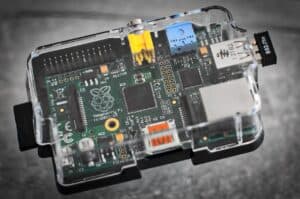This new model of the Raspberry Pi 5, with its enlarged 8GB of memory, presents an altogether different breed of affordable and pocket-portable device. This new device offers impressive performance improvements, whether for educational applications, do-it-yourself projects, or substituting desktops as needed. For example, if one had previously taken 5 minutes to boot, now it can accomplish it in only 38 seconds, which makes the Raspberry Pi 5 a “high performance, low price” product in this field. Specifications Upgraded for Raspberry Pi 5 8GB In this section, we look at how the revised specifications of the Raspberry Pi 5 8GB make it better suited to various uses—from casual at-home work to office-level tasks.
A Compact Yet Powerful Solution for Professionals
The Raspberry Pi 5 8GB is more than a toy for beginners and hobbyists. It’s also beginning to emerge as a legitimate option for professionals searching for small but powerful computing equipment. At its price point, it’s a far cheaper alternative to a traditional desktop computer for doing tasks that don’t call for the full capabilities of a high-end machine.
For example, the Raspberry Pi 5 8GB is an ideal lightweight development machine that provides the tools to write code, test applications, and build software in a compact environment. Its small form factor allows it to be used in environments where space is tight, such as embedded systems, robotics, and industrial automation.
Furthermore, the Raspberry Pi 5 8GB can be used by educators to introduce computing and programming to students. With much-improved processing power, the machine can run more sophisticated programming languages, simulations, and educational software beyond simple coding exercises.
Performance Upgrade: A Leap Forward
The Raspberry Pi 5 8GB has improved performance across all fields. While the previous models of the Raspberry Pi were very efficient in price, they often couldn’t handle big or demanding jobs. This Raspberry Pi makes substantial improvements in both processing power and memory. It can easily take on complex applications that previously defeated you.
The Raspberry Pi 5 uses a quad-core ARM Cortex-A76 processor, which offers faster clock speed than its predecessors. Additional CPU power means users can run software apps requiring more demanding computation tasks, such as video editing or three-dimensional modelling. Factories can now run programs on this latest model instead of being forced to purchase their computer system, and even daily tasks that took a long time in the past stand to be accelerated by those numerous new processor cores doing work all concurrently at blazing speed.
The Raspberry Pi 5, with its extra 8GB of onboard memory, also ships a new-generation graphics processor. This star upgrade to photographic performance adds 3D video output, etc. Thus, it has become a perfect choice for users requiring video playback or high visualisation in their projects. Interactive advertising displays and digital signage become typical applications in this ideal environment.
Improved Memory for Advanced Applications
The Raspberry Pi 5 8GB has 8GB of RAM, giving it a massive capacity leap. With more memory, users who need to run higher-end applications such as virtual machines, database management systems, and complex simulations can finally breathe easier. Moreover, superior memory handles multiple tasks simultaneously, like a busker with more than one hat. Increased RAM capabilities mean processing speeds increase and the overall user experience rises.
Compared to the 4GB version, the 8GB model can handle massive datasets and is much less likely to choke on intensive software than weaker microcomputers. This makes this model an excellent choice for users involved in advanced computing projects intended to drive the development of new AI systems or host relatively sophisticated web services. With this additional storage space, users will find everything runs more smoothly, with fewer system lags during operation.
Power Efficiency and Heat Management
Despite the enormous performance gain, the Raspberry Pi 5 8GB is still exceedingly power-efficient. Running from 5V, it guarantees both energy efficiency and outstanding ability. This is especially important for users who plan to run the device for extended periods without over-sweating the electric bill.
Moreover, the Raspberry Pi 5 8GB has been given some attention regarding heat management. More processing power mandates more capacity for generating heat, but the Raspberry Pi 5 is made for this work with improved cooling. Users who want to make the device run its hardest with long processes or intense workloads should get a fan or heatsink up and running. Nonetheless, these built-in improvements to the device help stop things from overheating when used in an ordinary way, which means that it can be merrily bearded under all the strain of a hefty load.
Versatility for DIY and Home Projects
A third area in which the Raspberry Pi 5 8GB excels is smart homes and do-it-yourself projects. Its enhanced performance makes it an excellent choice for building home servers, media centres, custom smart homes, and more. Whether you’re constructing a personal cloud storage service, making a network-attached storage (NAS) server, or setting up your home automation system, the Raspberry Pi 5 8GB can handle the jobs easily.
The more significant amount of RAM also allows for more extensive automation scripts to run an extended range of devices, sensors, and actuators. Incorporating the Raspberry Pi 5 8GB into smart home projects makes it a versatile tool for enthusiasts who want to create personal and highly functional living spaces.
Conclusion
This means it’s just as powerful but more straightforward than ever—a good buy for people who need an affordable, capable computer that can fit in their pocket. Here’s a little money saver for those who have it in mind to stuff the living room with purpose-built computers. With today’s imaginative software packages, the boundaries of affordable computing are endless. This product has the potential to revolutionise the computer industry. The Raspberry Pi now fills the space between low-fi Arduinos and expensive professional computer use. Users who have waited for the Raspberry Pi to reach this level of maturity but suited for them, as well as professionals alike, are now using it more and more as their go-to platform.




